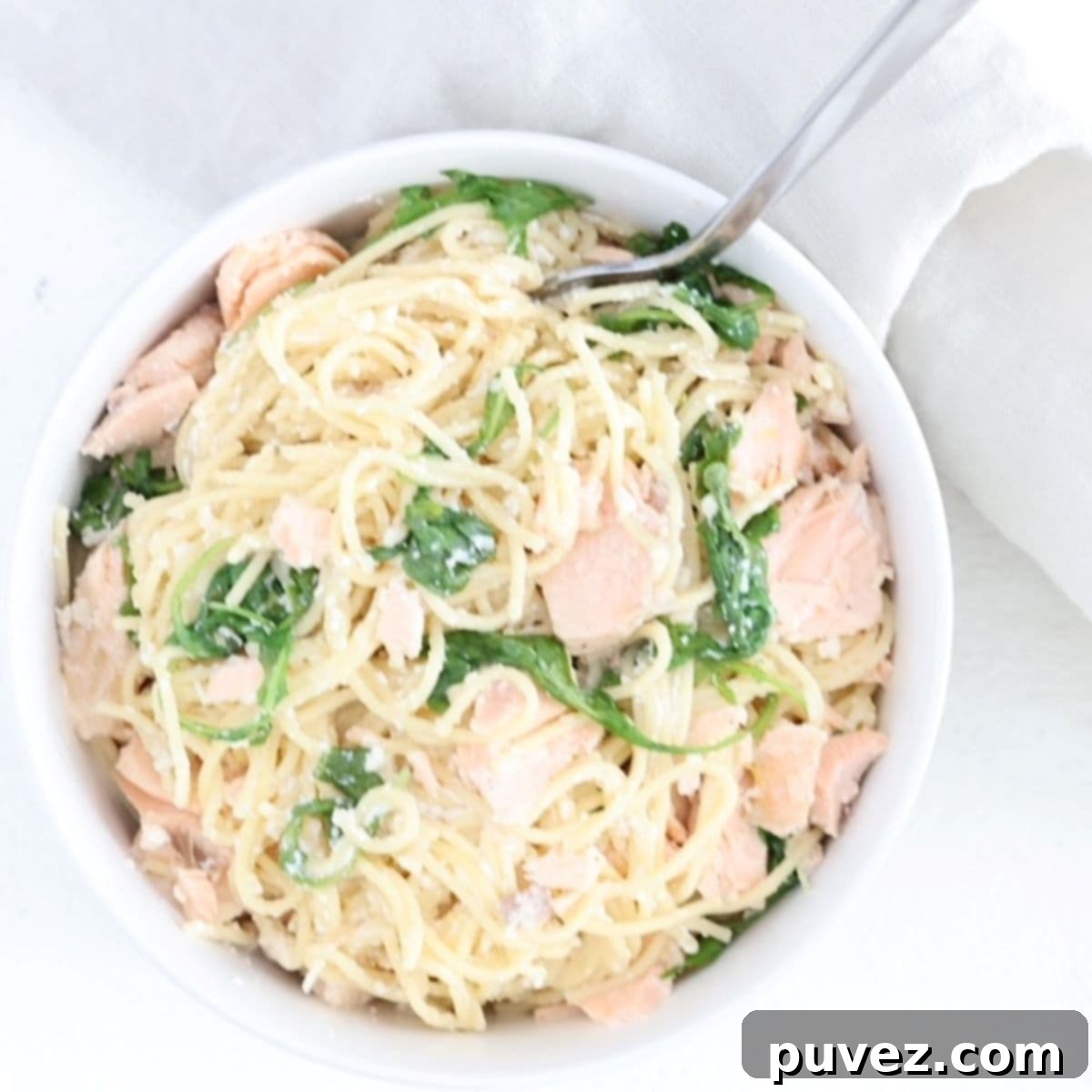Quick & Easy Creamy Salmon Pasta Dish: A 30-Minute Weeknight Delight
Discover how to make the **BEST, Quick & Easy Salmon Pasta Dish** with creamy ricotta, fresh arugula, and zesty lemon. This delightful seafood pasta comes together in just **30 minutes**, making it the perfect weeknight meal. Prepare to be amazed – pasta with salmon has never tasted so incredible!
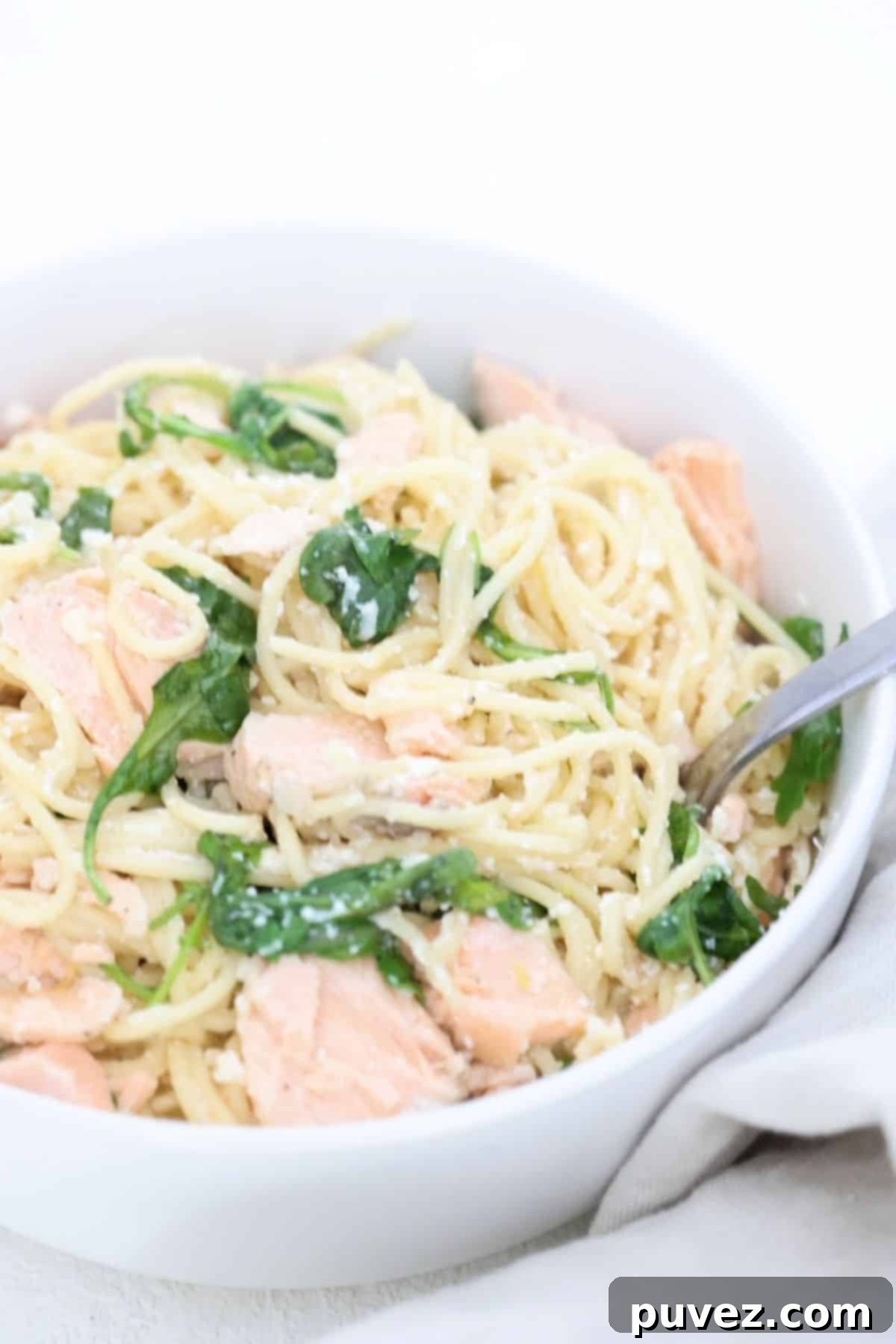
As a passionate home cook, I often find inspiration for new recipes from unexpected places – whether it’s an exquisite dish at a restaurant or a homemade meal shared among friends. This deliciously simple and creamy salmon pasta recipe is no exception!
My culinary journey for this particular dish began during a recent trip to Amsterdam. I ordered a sophisticated-sounding poached salmon, and its delicate texture and rich flavor left a lasting impression. That experience sparked an idea: how could I recreate that elegance at home, but in a quicker, more accessible way? Restaurants often rely on simple, efficient techniques to serve a diverse menu swiftly, and I realized poaching salmon could be one such technique.
After a bit of research and practice, I discovered that poaching salmon is incredibly straightforward and takes less than 10 minutes – truly a game-changer! This quick-cooking method maintains the salmon’s tender, flaky texture, making it perfect for incorporating into a variety of dishes. Eager to find new and delicious ways to introduce more seafood into our family’s diet, I decided to pair this perfectly poached salmon with a pasta dish. The result? A resounding success! Even my notoriously picky family, who typically shy away from dishes featuring ricotta cheese, absolutely adored it.
Don’t let the idea of poaching salmon intimidate you! If you can boil pasta, you can absolutely poach salmon. It’s an effortless technique that yields perfectly cooked fish every time. Let me guide you through just how easy it is to create this flavorful and healthy salmon pasta dish that your entire family will love!
Why You’ll Adore This Easy Salmon Pasta
This creamy salmon pasta dish isn’t just a meal; it’s a culinary triumph designed for busy lives and discerning palates. Here’s why it will quickly become a cherished favorite in your recipe rotation:
- Effortlessly Simple Recipe: You’ll be amazed at how streamlined the cooking process is. The pasta cooks to al dente perfection in one pot, while the salmon gently poaches in a separate skillet. Then, it’s just a matter of combining everything with a few simple ingredients. While it might feel like a new technique the very first time, you’ll quickly master it and realize just how incredibly easy and intuitive this salmon pasta dish truly is. It’s a fantastic recipe for novice cooks and seasoned chefs alike!
- A True 30-Minute Meal: Say goodbye to lengthy cooking sessions! This recipe is engineered for speed. By poaching the salmon while the pasta boils and prepping your other ingredients concurrently, you can have a wholesome, delicious, and satisfying dinner on the table in just 30 minutes from start to finish. It’s an absolute lifesaver for those hectic weeknights when time is of the essence but you still crave a homemade meal.
- Excellent for Meal Prep: Poached salmon is a dream ingredient for meal prepping. Its delicate flavor and flaky texture make it incredibly versatile. Prepare a larger batch of poached salmon at the beginning of the week, and you can effortlessly add this healthy protein to a variety of meals. Think fresh green salads, vibrant grain bowls, gourmet avocado toast, or, of course, delightful creamy pasta dishes like this one. It’s a smart way to ensure you have quick, healthy protein options readily available.
- Family-Friendly & Kid Approved: This salmon pasta dish boasts a subtly mild flavor profile and a wonderfully creamy texture, making it a hit even with the most finicky eaters. I honestly expected some complaints from my kids (and husband, let’s be real! 😉) when I first served this creamy salmon pasta. To my pleasant surprise, I was completely wrong! Even my usually hard-to-please teenage daughter declared, “this is actually good!” and happily devoured the leftovers the very next day. It’s a fantastic way to introduce more seafood into your family’s diet without any fuss. 🙌
Dietitian’s Insight: Boosting Seafood Intake
As a registered dietitian, I often emphasize the importance of seafood in a balanced diet. The Dietary Guidelines for Americans consistently recommend that people of all ages increase their seafood consumption. Seafood, especially fatty fish like salmon, is packed with essential nutrients, including high-quality protein, vitamins, and minerals. Most notably, it’s an excellent source of omega-3 fatty acids, which are crucial for brain health, cardiovascular well-being, eye function, and even mental health.
However, getting my own family to eat seafood regularly isn’t always a straightforward task, even for a dietitian! Simply making it doesn’t guarantee they’ll eat it, as many parents can attest. This recipe, with its mild flavor and comforting pasta base, serves as a wonderful reminder that sometimes, it’s not just *what* you serve, but *how* you serve it – or not just *what* you cook, but *how* you prepare it – that makes all the difference.
If your family isn’t keen on traditional pan-seared salmon, don’t give up! Experiment with different cooking methods. Perhaps they’ll enjoy the smoky flavor of cedar plank salmon, the crispy texture of air-fried salmon (like this easy air fryer method), or a perfectly roasted fillet. The key is to explore and find what resonates with their taste buds.
And if serving salmon as a standalone main dish with sides isn’t their favorite, try integrating it into a beloved meal. Adding flaked salmon to a creamy pasta dish, like this one, transforms it into a familiar and comforting meal that subtly introduces the benefits of seafood. It’s a clever way to boost nutrient intake without compromising on flavor or family enjoyment.
Exciting Recipe Variations to Try
While this recipe offers a simple yet incredibly delicious creamy pasta dish with salmon, it’s also a fantastic canvas for culinary creativity. Don’t hesitate to experiment with different flavors and textures. If you try a unique variation, please let me know – I’d love to hear about it!
- A Burst of Fresh Herbs: Elevate the aroma and flavor by incorporating fresh herbs. Finely chopped fresh parsley offers a clean, bright note, fresh basil adds a hint of sweetness and peppery undertones, while fresh dill complements salmon beautifully with its delicate, slightly anise-like flavor. Stir them in along with the arugula for an extra layer of freshness.
- Sweet Cherry Tomatoes: For an added pop of color, sweetness, and a lovely textural contrast, stir in some cherry tomatoes. You can leave them whole for bursts of juicy flavor or cut them in half for a more integrated bite. They pair wonderfully with the creamy sauce and fresh arugula.
- A Touch of Heat with Red Pepper: My cousin in Holland loves a little kick in her pasta dishes! She often sautés finely diced hot peppers to add a vibrant spice. For a simpler approach, a dash or two of cayenne pepper or a sprinkle of red pepper flakes stirred into the pasta sauce will provide a delightful warmth and gentle heat.
- Garlic Lover’s Dream: If you’re a true garlic aficionado and have a few extra minutes, consider sautéing two to three fresh minced garlic cloves in a tablespoon of extra-virgin olive oil in the large pot after you’ve drained the pasta. This adds a deeper, more aromatic garlic flavor to the dish. Alternatively, simply increase the amount of garlic powder for a quicker boost.
- Utilize Leftover Salmon: This recipe is wonderfully adaptable for using up leftover salmon. Whether you have roasted, grilled, pesto salmon, or pan-seared salmon on hand, feel free to flake it and incorporate it instead of poaching fresh fillets. This not only saves time but also reduces food waste. In a pinch, even good quality canned wild salmon can be a convenient and tasty substitute in this versatile seafood pasta dish.
Key Ingredients for Success
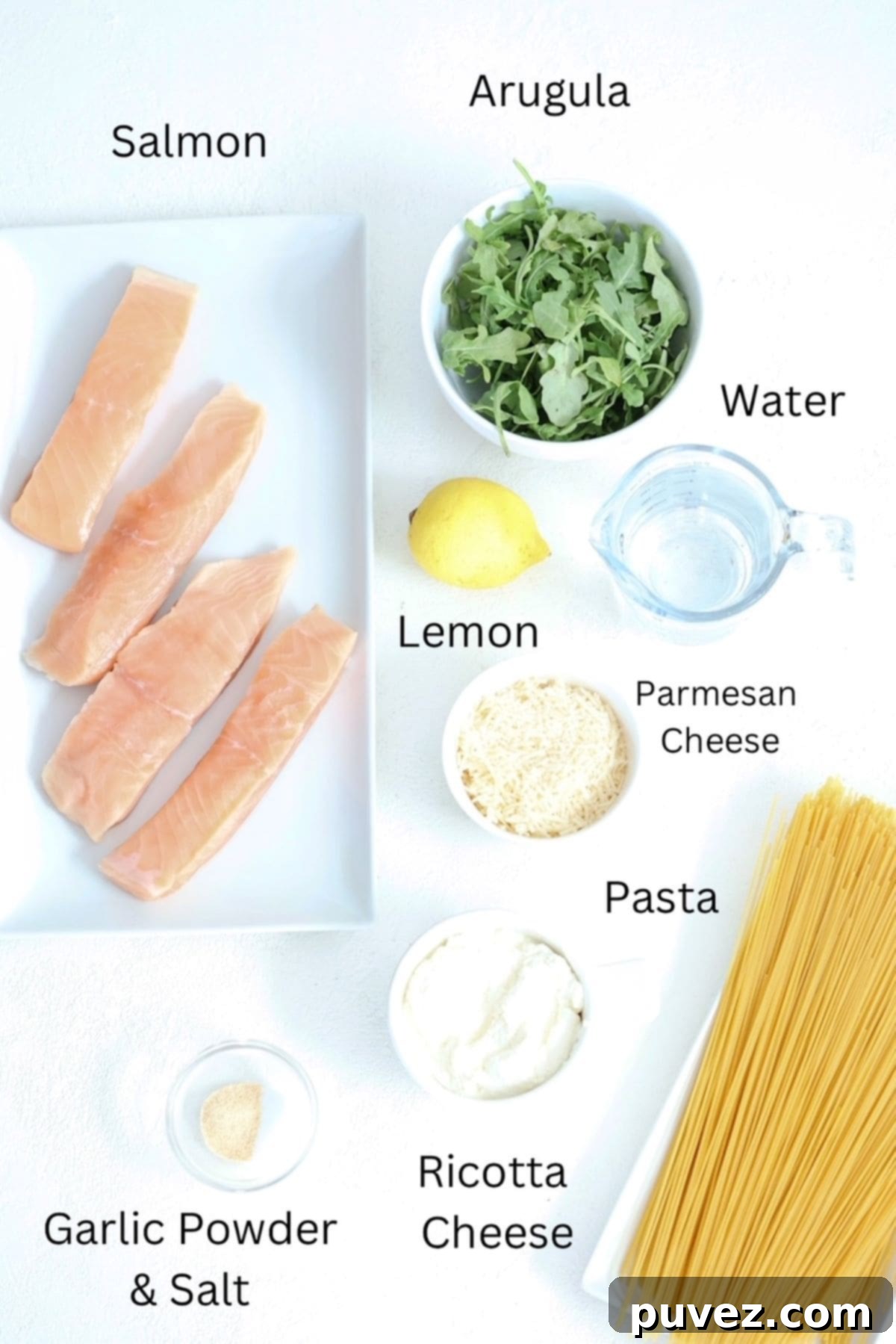
Crafting this easy salmon pasta dish relies on a few high-quality, flavorful ingredients that come together harmoniously. Here are the highlights. For the complete list with precise measurements, please refer to the detailed recipe card below.
- Salmon Filets: The star of our dish! Salmon is a nutritional powerhouse, offering an excellent source of lean protein and a rich supply of omega-3 fatty acids. These “heart-healthy fats” are vital for supporting brain function, cardiovascular health, sharp eyesight, and even mental well-being. I highly recommend using wild-caught salmon fillets for their superior flavor and nutritional profile. Both fresh and defrosted (from frozen) fillets will work beautifully.
- Pasta: The foundation of any great pasta dish! I personally love using Barilla Protein Plus spaghetti pasta. It’s a fantastic choice because it boasts the familiar taste and texture of regular spaghetti but delivers added protein and fiber, thanks to a blend of wholesome ingredients. However, feel free to use your favorite long pasta – thin spaghetti or angel hair pasta would also be excellent choices.
- Lemon: Freshness is key! Always opt for fresh lemon juice and zest. The bright, acidic notes of fresh lemon zest and juice are an incredibly easy way to enhance the overall flavor profile of the dish, adding a vibrant zing without requiring a lot of extra effort or complex ingredients.
- Cheese: This recipe achieves its delightful creaminess without heavy cream! Instead, a combination of smooth ricotta cheese and salty parmesan cheese, along with some of the reserved poaching liquid, creates a wonderfully rich and velvety sauce. It’s a lighter alternative that still provides that luxurious mouthfeel. As mentioned, my family typically isn’t keen on ricotta, but its subtle presence here is a winning factor.
- Arugula: A peppery green that adds a fantastic fresh bite. Baby arugula is a delicate leafy green, usually found in the produce section alongside baby spinach. Its slightly peppery flavor provides a lovely contrast to the rich salmon and creamy pasta. If arugula isn’t available or preferred, baby spinach makes a perfectly acceptable and equally nutritious substitute, wilting nicely into the warm pasta.
Mastering Poached Salmon: A Simple Technique
Poaching salmon is an elegant yet incredibly time-saving cooking method that yields exceptionally tender and flaky fish. It’s much simpler than it sounds, and once you try it, you’ll wonder why you haven’t been doing it all along! Let me show you how it’s done:
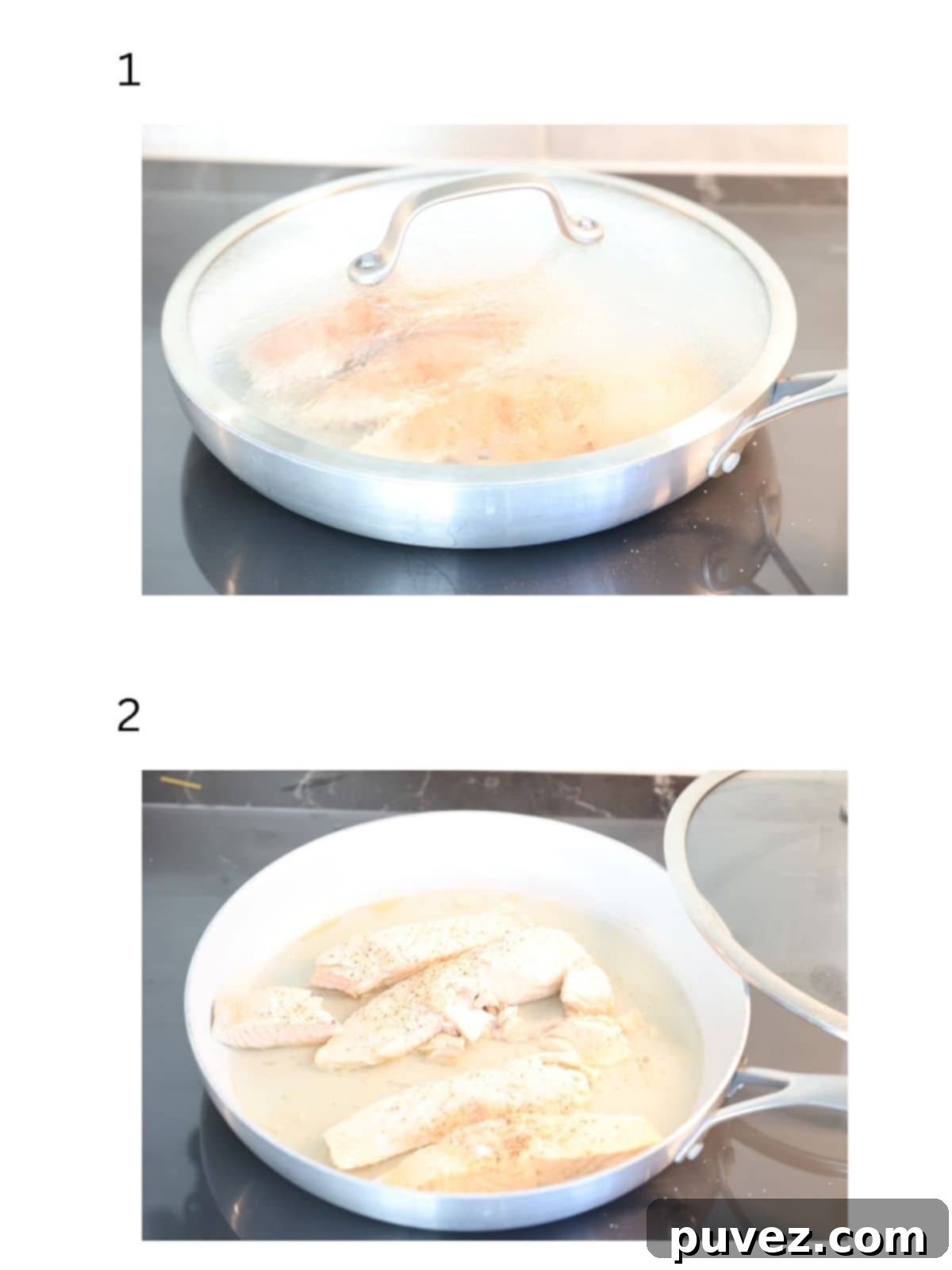
- Prepare the Poaching Liquid: Begin by adding your chosen broth or water to a large skillet. Bring this liquid to a gentle simmer. You don’t want a rolling boil; just small, consistent bubbles breaking the surface. I typically set my stovetop to just over medium heat for this. A gentle simmer ensures the salmon cooks evenly and stays moist.
- Poach the Salmon: Carefully place the salmon fillets into the simmering liquid, skin side down. Cover the skillet with a lid. Allow the salmon to cook for approximately 6-8 minutes. The exact cooking time may vary slightly depending on the thickness of your fillets. The salmon is perfectly cooked when its internal temperature reaches 145 degrees Fahrenheit (use a digital food thermometer for accuracy) or when it easily flakes with a fork. Overcooked salmon can become dry, so keep a close eye on it!
- Flake and Reserve: Once cooked, carefully remove the salmon fillets from the skillet and transfer them to a plate. Crucially, **do not discard the poaching liquid!** This flavorful liquid is key to achieving the perfect creamy texture in your pasta sauce. With a fork, gently flake the salmon, removing any skin as you go. Set the flaked salmon aside while you prepare the pasta.
Bringing it All Together: Making the Creamy Salmon Pasta
This salmon pasta dish is a fantastic example of culinary multitasking. You’ll be poaching the salmon while your pasta cooks, making for an incredibly efficient and quick meal. Once both main components are ready, it’s just a matter of stirring in a few more ingredients to create a rich, creamy, and flavorful dish. For the complete step-by-step instructions, including precise measurements, please scroll down to the comprehensive recipe card below.
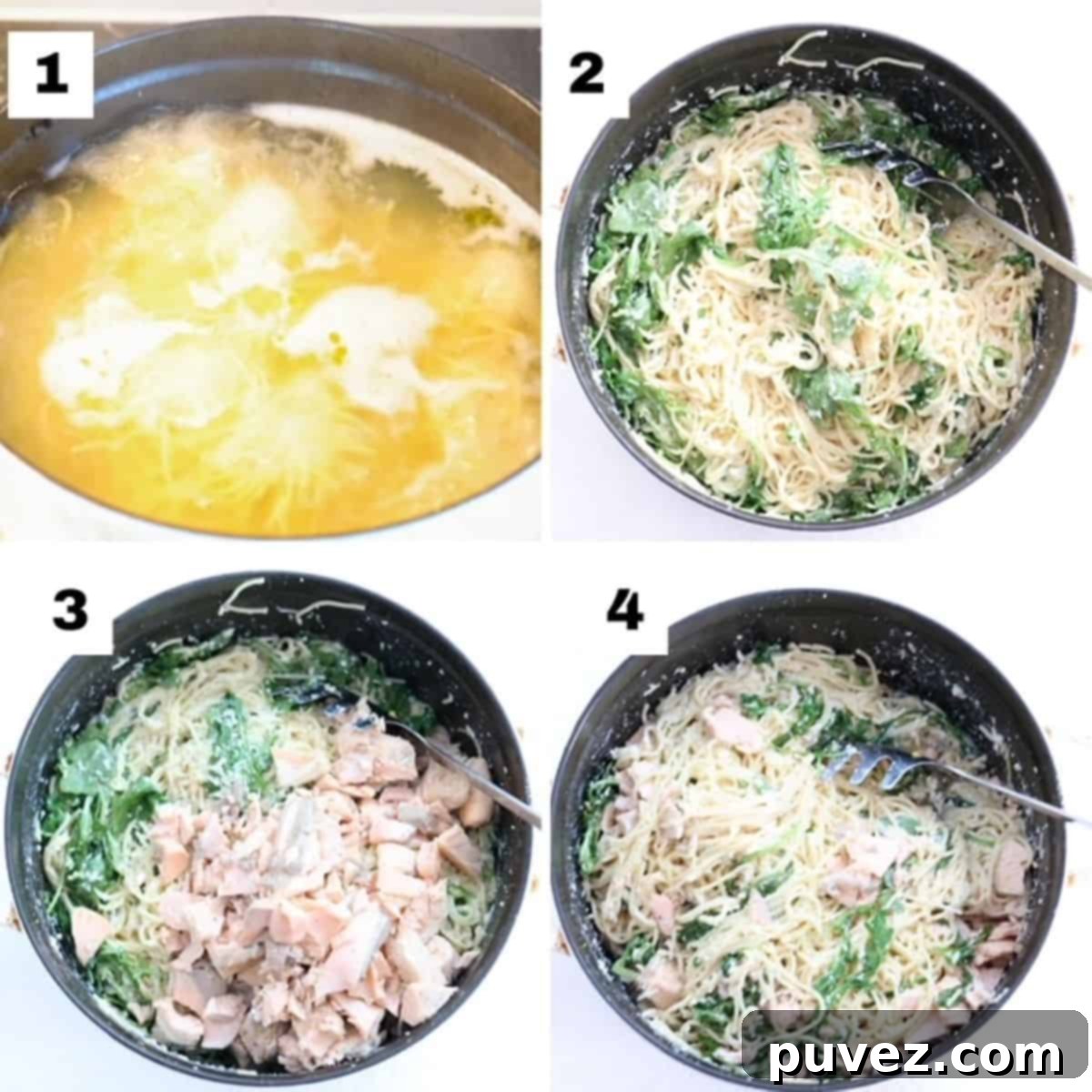
- Cook the Pasta: While your salmon is poaching, bring a large pot of salted water to a rolling boil. Add your spaghetti and cook it according to the package instructions until it reaches al dente. This means it should be firm to the bite, not mushy. Once cooked, drain the pasta, but make sure to return it immediately to the same pot. Reduce the heat on your stovetop to low to keep the pasta warm.
- Create the Creamy Base: With the cooked pasta back in the pot, pour in the reserved poaching liquid from the salmon. This liquid is packed with flavor and contributes significantly to the sauce’s body. Now, stir in the ricotta cheese, fresh baby arugula, garlic powder, and salt until everything is well combined and the arugula begins to wilt slightly.
- Add Lemon & Parmesan: Next, add half a cup of the shredded parmesan cheese, the bright lemon juice, and the aromatic lemon zest. Stir these ingredients thoroughly into the pasta. The lemon zest and juice will brighten the entire dish, while the parmesan adds a salty, umami depth.
- Fold in Salmon & Serve: Finally, gently fold in the flaked, cooked salmon pieces along with the remaining parmesan cheese. Be careful not to break up the salmon too much; you want nice, tender flakes throughout the dish. Stir just enough until the salmon is evenly distributed within the creamy pasta. Serve immediately and savor every bite of this quick, easy, and incredibly flavorful salmon pasta dish!
Pro Tips for the Perfect Salmon Pasta
To ensure your creamy salmon pasta dish turns out perfectly every time, keep these helpful tips in mind:
- Efficient Timing is Key: Maximize your cooking efficiency by poaching the salmon simultaneously while the pasta boils. This overlapping of tasks is what allows you to get dinner on the table in under 30 minutes!
- Avoid Overcooking Salmon: Poached salmon cooks quickly. Keep a close eye on it and remove it from the heat as soon as it reaches the recommended internal temperature or flakes easily. Overcooked salmon can become dry and tough, losing its delicate texture.
- Naturally Creamy, Not Heavy: This recipe delivers a wonderfully creamy texture without relying on heavy cream or a rich cream sauce. The combination of ricotta cheese, parmesan, and the reserved poaching liquid provides just the right amount of luxurious creaminess, keeping the dish lighter yet incredibly satisfying.
- Choose the Right Pot: This recipe yields a generous amount, perfect for feeding a family or having delicious leftovers. To accommodate all the ingredients comfortably, ensure you use at least a five-and-a-half-quart Dutch oven or a similarly sized large pot for cooking your pasta and mixing the dish.
- Adjust Salmon Cooking Time: Salmon fillet thickness varies, so be prepared to adjust your poaching time. Thicker fillets will naturally require a little longer to cook through, while very thin fillets might be ready in as little as 5 minutes.
- Frozen Salmon is Fine: Don’t have fresh salmon? No problem! I’ve successfully made this dish using frozen salmon fillets. Just be aware that they will take slightly longer to cook than fresh ones. Ensure they are fully defrosted before poaching for the best results, or add a few extra minutes to the poaching time if cooking from frozen.
- Arugula Amount is Flexible: If you’re accustomed to having a generous amount of cooked greens in your recipes, you might initially feel tempted to add more arugula. When I first made this, I thought, “Next time, more arugula!” However, my family quickly advised against it, saying, “No, don’t add more, or it will taste like a salad.” It’s a matter of personal preference, so feel free to adjust to your liking, but be mindful of balancing the flavors.
- Season the Salmon Wisely: When poaching salmon in plain water, I like to add a pinch or two of salt and black pepper directly to the fillets to enhance their flavor. However, if you’re using chicken broth or another flavored broth for poaching, I typically skip adding extra salt to the salmon, as the broth itself will provide seasoning.
Frequently Asked Questions
Allow any leftover salmon pasta to cool completely to room temperature before storing. Transfer it to an airtight container and refrigerate promptly. It will stay fresh and delicious for up to 3 days. I do not recommend freezing this dish, as the texture of the pasta, ricotta, and salmon can change unfavorably upon thawing.
The most reliable indicator that salmon is perfectly cooked is when it flakes easily with a fork in its thickest part. Some chefs suggest removing salmon from heat when it reaches an internal temperature of 130-135 degrees Fahrenheit for a very moist finish, allowing for carryover cooking. However, the FDA advises cooking seafood to an internal temperature of 145 degrees Fahrenheit for food safety. Recently, my digital food thermometer broke, so I relied on the ‘flake with a fork’ method, and it worked beautifully, yielding tender, moist salmon.
This salmon pasta dish is wonderfully hearty and satisfying on its own, making it ideal for busy weeknights. For simple sides, I often pair it with a slice of crusty sourdough bread, some refreshing applesauce or sliced apples, a crisp green salad, or perfectly roasted air-fried broccoli parmesan. If you have a bit more time and ingredients, a vibrant Tuscan kale salad makes an exceptional pairing; its bold flavors, especially with lemon and garlic, will truly complement this pasta.
Absolutely! While spaghetti is recommended for its classic appeal, this recipe is incredibly versatile. Short pasta shapes like penne, rotini, or farfalle would work just as well, capturing the creamy sauce beautifully. Feel free to use your favorite pasta shape based on what you have on hand or what your family prefers.
Explore More Delicious Seafood & Pasta Recipes
If you enjoyed this easy and flavorful salmon pasta, you’ll love these other simple and satisfying dishes:
- Easy Pasta with Tuna: Another quick and budget-friendly seafood pasta option.
- Orzo with Broccoli: A light and fresh pasta dish that’s perfect for a vegetarian meal or as a side.
- Asian-Inspired Noodle Bowl: For when you’re craving something different, packed with flavor and vibrant ingredients.
- 10-Minute White Cheddar Mac n Cheese: A super speedy and comforting classic that’s always a hit.
More Dinner Inspirations
- Butternut Squash Pasta Sauce
- Easy Peanut Butter Sauce for Noodles
- Apple Cider Vinaigrette Dressing
- Basil Balsamic Dressing
Did you make this easy Salmon Pasta Dish and love it as much as we do? I’d be absolutely thrilled to hear from you! Please let me know by leaving a comment and a ⭐⭐⭐⭐⭐ rating below. A 5-star rating is truly the best compliment and helps other home cooks discover this delicious recipe!
Remember to follow me on Pinterest and Instagram for more quick, easy, and nutritious recipes, complete with valuable dietitian-approved tips!
📖 Recipe

Easy Creamy Salmon Pasta Dish
Kristi
Pin Recipe
Equipment
-
1 Large pot
-
1 Large skillet with a lid
-
1 Strainer
-
1 citrus zester
Ingredients
Creamy Pasta with Arugula and Lemon
- 14.5 ounces spaghetti (14.5-16 ounces. I like to use Barilla + Protein spaghetti pasta)
- 12 ounces ricotta cheese (1½ cups)
- 3 ounces baby arugula (2 large handfuls. Can use baby spinach instead.)
- 1 lemon (zest and juice of one lemon)
- ½ teaspoon garlic powder
- ½ teaspoon salt (table salt or sea salt)
- ¾ cup parmesan cheese (shredded, divided)
Poached Salmon
- 1½ cups broth or water
- 1 pound salmon (4, 4-ounce fillets)
Instructions
Poached Salmon
-
Prepare to Poach: Add 1½ cups of broth or water to a large skillet. Bring the liquid to a gentle simmer (just over medium heat, with small bubbles breaking the surface). Once simmering, carefully place the salmon fillets, skin side down, into the liquid. Cover the skillet with a lid.1½ cups broth or water
-
Cook the Salmon: Simmer the salmon for approximately 6-8 minutes. The salmon is perfectly cooked when its internal temperature reaches 145 degrees Fahrenheit, or when it easily flakes apart with a fork. Be careful not to overcook.
-
Remove and Reserve: Carefully remove the cooked salmon from the skillet and transfer it to a plate. **Crucially, reserve the poaching liquid** – you will be adding this flavorful liquid to the cooked pasta.
-
Flake the Salmon: Using tongs and a fork, gently remove the skin from the salmon and flake the fish into bite-sized pieces. Set the flaked salmon aside.
Pasta with Arugula and Lemon
-
Cook the Pasta: While the salmon is poaching, bring a large pot of salted water to a boil. Add the 14.5 ounces of spaghetti and cook it according to package instructions until it’s al dente (firm to the bite).14.5 ounces spaghetti
-
Drain and Return: Drain the cooked pasta, then immediately return it to the same large pot. Place the pot back on the stove and reduce the heat to low to keep it warm.
-
Add Creamy Ingredients: Stir in the 12 ounces of ricotta cheese, 3 ounces of baby arugula, ½ teaspoon of garlic powder, and ½ teaspoon of salt into the warm pasta until well combined and the arugula begins to wilt.12 ounces ricotta cheese, 3 ounces baby arugula, ½ teaspoon garlic powder, ½ teaspoon salt
-
Incorporate Poaching Liquid: Once the salmon is done cooking (and you’ve reserved the liquid), add the poaching liquid to the cooked pasta mixture.
-
Finish the Sauce: Stir in ½ cup of the shredded parmesan cheese, the zest of one lemon, and the juice of one lemon. Continue to mix until everything is evenly distributed.1 lemon, ¾ cup parmesan cheese
-
Add Salmon and Serve: Gently add the flaked salmon pieces and the remaining ¼ cup of parmesan cheese to the pasta. Carefully stir to combine, ensuring the salmon is evenly distributed without breaking it up too much.
-
Enjoy: Serve your delicious creamy salmon pasta immediately and savor every forkful!
Notes
- This dish offers a delightful creaminess that is rich but not overly heavy. It achieves its luscious texture without the use of heavy cream or a traditional cream sauce, relying instead on ricotta cheese, parmesan, and the flavorful poaching liquid for the perfect balance.
- Feel free to adapt this recipe by using roasted, pan-seared, canned, or even air-fried salmon instead of poaching. It’s a versatile dish that works well with various preparations of salmon.
- To maintain the salmon’s tender, flaky texture, it’s crucial not to overcook it. Keep an eye on the cooking time and visual cues.
- If using frozen salmon fillets, they will generally require a slightly longer cooking time than fresh fillets. Adjust accordingly to ensure they are cooked through.
- To save time and streamline your cooking process, always aim to poach the salmon simultaneously while your pasta is boiling.
- When poaching salmon in plain water, I recommend adding a pinch or two of salt and black pepper directly to the fillets to enhance their flavor. However, if you are using a seasoned broth (like chicken broth), you can typically skip adding extra salt to the salmon during poaching.
- The amount of arugula is adjustable to your preference. If you enjoy a more pronounced green presence in your pasta dishes, feel free to add a bit more. Just be mindful that a very large quantity might shift the flavor profile closer to a salad.
- The cooking time for salmon can vary based on the thickness of the fillets. Thicker pieces will naturally take longer, while very thin fillets might cook in as little as 5 minutes. Use a food thermometer for accuracy, or rely on the “flake with a fork” test.
- This recipe makes a substantial amount, so for comfortable cooking and mixing, plan to use a large pot or Dutch oven with a capacity of at least five and a half quarts.
Nutrition
